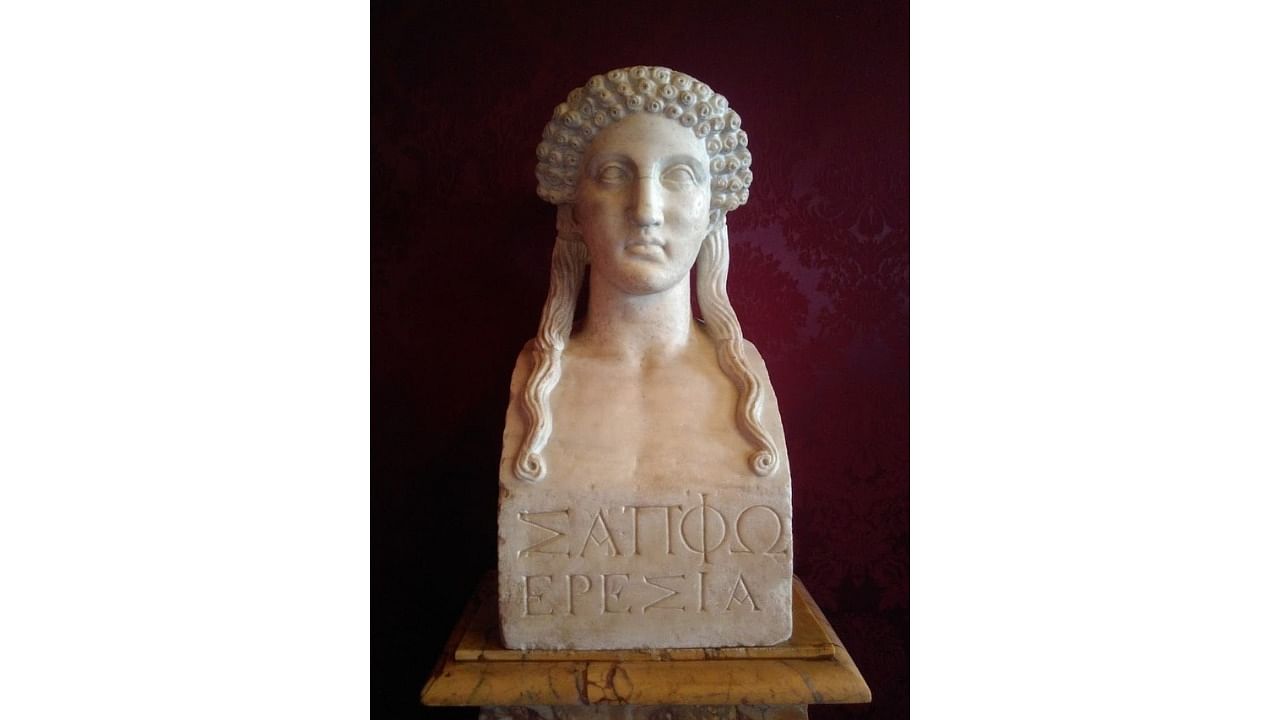
Sappho lived on the island of Lesbos, Greece in the 6th century BC. The word ‘lesbian’ is derived from ‘Lesbos’, the island which became famous because of Sappho’s poetry. ‘Lesbian’ means the most famous woman from ‘Lesbos’, that is Sappho. Some of her poems reveal a profound expression of love of a woman for another woman. Also, through her woman-centred narratives, we can recognise intense emotions a woman can express simultaneously, for both men as well as women.
Thus, her poetry demonstrates that, if social norms don’t bind a woman, her thinking and imagination can construct a different world, where a woman is an epitome of love. Also, she can express her heartfelt desires quite freely, like a man normally does in our world.
Explorations by different researchers have revealed that, though Sappho must have written around 10,000 poetic lines, only 650 lines are available now, that too in bits and pieces. A poem titled ‘Ode to Aphrodite’ is in complete form and the rest, 70 jumbled lines and a few single words.
In this context, if we revisit Greek literary tradition, we get ample evidence for Sappho’s popularity in her times. In Greek society, though there were hardly any women voices in the public domain, Sappho made her presence felt through her poems. Though society expected a man and a woman to have a conjugal relationship, there were no restrictions on same-sex alliances.
So, Sappho’s poetry which unravels a woman’s true feelings for another woman was accepted as a natural phenomenon. Especially, women readers could identify themselves in her poems, so they celebrated them by writing on porcelain, shared, danced and sang with other women.
As a testament to her popularity, statues were erected in her honour, also her name and images were imprinted on coins. Although, Plato claimed that, ‘an ideal state has no place for poetry’, he appreciated Sappho’s works and described her as the “Tenth Muse.”
Aristotle too commended that, ‘Sappho deserves respect, though she is a woman’. The Greeks in general compared her works to legendary Homer and called her, a ‘female Homer’.
Yet, it is surprising that Sappho got almost erased in the pages of the great Greek tradition, unlike her male counterparts. So, it would be interesting to explore, why did this happen?
Some accounts say that after Christianity became popular, in 2nd century AD, Pope Gregory ordered the burning of the copies of Sappho’s poems, as they express same-sex love, which was perceived to be against religion. Another reason could also be that Sappho wrote her poems in the ‘Aeolic’ Greek dialect, which is difficult to translate, and the following generations lost interest in them.
However, after a long period of obliviousness, Sappho found her place in mainstream literature in the 20th century, when homosexuals began to fight for their rights across the globe. For them, Sappho appeared highly relevant, so, her poems were translated, popularised and widely read. Also, the LGBTQ community started flocking Lesbos, where once Sappho lived, to celebrate their identity.
Though there are no authentic sources to reveal Sappho’s life journey, some evidence suggests that she ran a girls’ school in Lesbos. Also, wealthy parents of the island sent their girls to her school to get trained in rhetoric. During those times, songs were composed to perform with musical instruments, in public ceremonies. Similarly, Sappho too learnt to play ‘Lyre’ and sang her songs to the community.
Sappho wrote elaborately on the theme of romantic interests of a woman. In her poems, we meet a woman who is intensely attracted to another woman. As a result, Sappho was labelled as lesbian, in the later periods, although there was no evidence to say so. However, in her poetry, there is definitely an image of the woman’s worldview, which is beyond the imagination of a man. Critics appreciate her narrative techniques and creative style. She invented a new meter, better known by her name, ‘Sapphic Meter’ for her poetry.
Some of her lines demonstrate how intensely Sappho expressed her feeling as a woman, for both men and women: “You came and I was longing for you. You cooled a heart that burned with desire.”, “Once again love drives me on, that loosener of limbs, bittersweet creature against which nothing can be done.”, “In the crooks of your body, I find my religion.”, “Stand and face me, my love, and scatter the grace in your eyes.”
It is quite astonishing and refreshing as well, to know that almost 2,500 years ago, a woman poet expressed her sensations of love so vividly and freely without any social constraints.
(The writer is an assistant professor of English, Tumkur University)